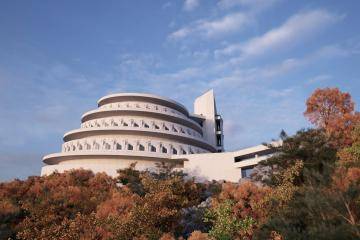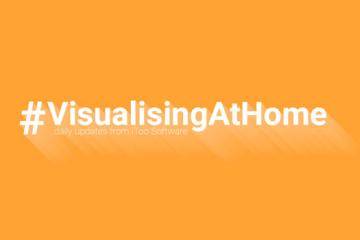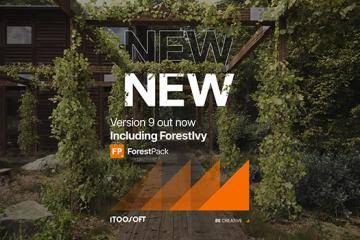Новости
Ознакомьтесь с последними разработками от ITOOSOFT

It's always interesting to discover new or unusual applications for Forest Pack. Sometimes this is a use for the plugin that our developers had never anticipated, at other times Forest Pack finds foothold in a new industry. The latter is frequently true for sectors where high quality photorealistic rendering, now mainstream in architecture and VFX, has yet to become the norm but is on the rise.
Civil Engineering is one such area, and we're pleased to present a case study written by Sebastian Torstenson drawing on his research during a Masters Degree in Transport Engineering. Engineers in this sector typically don't have a visualisation background and wouldn't consider themselves to be 3D artists, so ease-of-use and speed are of paramount importance. Sebastian's research focused on creating an accessible and rapid rendering pipeline, including an investigation into the use of Forest Pack to add site context and realism to road traffic simulations created with TSS AIMSUM and brought to life in 3DS Max. His findings can be read below, but if you have any questions or comments, please let us know on our forum or by dropping us an email.
Introduction:
My name is Sebastian Torstenson and I am a newly qualified transport engineer. I was educated at The Norwegian University of Science and Technology (NTNU), where I recently completed my master thesis: "3D visualization of road projects with traffic models, 3ds Max 2016 and AIMSUN". Below you can see one of the final animations created to demonstrate how traffic simulations can be visualised, using the the changing traffic conditions of a fictional road in the years 2016 and 2035 as an example.
The master thesis examined the possibility of combining the use of 3D visualisation and traffic simulation software. Autodesk 3ds Max and TSS AIMSUN were used to give a more comprehensive view of future road projects in Norway. Based on both interviews and my own ideas, I believe there is an unrealised potential for more realistic presentations of civil projects. By unleashing the potential, one hope is that that this will give decision-makers, and especially those with less technical knowledge, a more solid foundation for their choices.
I should point out that my education is from the Department of Civil and Transport Engineering, so my approach and expectations differ from that of a 3D artist. The master thesis was written over a time period of 6 months.
Background to the project/brief:
Some engineering companies have already explored setups similar to the one suggested in my master thesis, but the extent of use is limited. This is because it is a time-consuming process. The focus was therefore always to find the best balance between time efficiency and visual quality with a setup that is economically defensible for use in both large and small road/transport projects. This includes a more efficient way of creating precise road networks for traffic simulation in AIMSUN, and for enhanced realism, it was important to find an efficient way of handling large terrain models, with high-density vegetation. If I was able to achieve this, it could be the only method for creating a 3D visualisation that incorporates traffic simulations comparable in efficiency to normal 3D visualisation.
The use of Forest Pack Pro in my research:
The main purples of the use of Forest Pack Pro was to achieve a more realistic and professional representation of the traffic situation in road projects. A presentation of the calculated traffic flow can be a very useful and powerful technique for giving decision-makers a comprehensive overview of a future road project. It is also important to remember that the cost of large road projects, even in Norway, easily could be 100+ million USD.
One of the biggest challenges was being able to create vegetation over large terrain surfaces, based on the orthographic photography underneath. It had to be fast and efficient, and perhaps most importantly, render times had to be kept as low as possible. One of the reasons it had to be fast is because the time used for setting up the 3d-model itself, including the import and animation of traffic, should be the most time-consuming part of the process.
My experience with Forest Pack for handling high-density vegetation over large areas was excellent. The ability to just “paint” vegetation directly on the 3d-terrain was a huge time saver. Being able to view complex vegetation as a “points-cloud” was also a very good feature, making the large-scale environments much easier to handle and preview in the viewports. I also found the ability to create diversity in the vegetation using different tree types, scaling, and orientation very helpful.
In my work, I divided the use of vegetation into three levels. One without the use of FP, just orthogonal photography and separate low-res textures for fields and paths (gravel) etc. At “level 2”, I used trees only, but over large areas. At “level 3”, I use vegetation, as well as stones and gravel, on all surfaces in the terrain model.

Figure 1 – Rendering without Forest Pack Pro, “level 1”

Figure 2– Rendering with trees only, “level 2”

Figure 3– Rendering with full vegetation, “level 3”
For flyover shots, I found that using just trees gave a good balance between time efficiency and visual result. I used V-Ray RT as a production render and at 1920x1080, I was pleased with the number of render passes completed in about 3 minutes per frame. For close-ups, the use of full vegetation on all surfaces gives a much more realistic presentation, but with my hardware I was just able to get a decent result after 15-min of rendering. The rendering was done with an NVidia GTX 970.
The rendering time proved to be one of the biggest concerns regarding an efficient setup. This was partly because I was not able to catch all the visual errors in the 3D model before rendering. Going back and fixing them and rendering again took too long. For use in smaller road/transport projects it also important that you can deliver final renders in a short time. I found that the best solution was to turn off all vegetation and render every 12 frame or so. Then, when the car animation and roads rendered correctly, I turned on the vegetation back on. Forest Pack's way of handling different vegetation applied to the model was very good, and this made the job much easier.
Challenges and limitations with the use of Forest Pack Pro:
Other than render times for complex scenes, there were some minor challenges with the use of FP. Mainly this was due to the limitations when V-Ray RT was used as production render. The missing support for “Edge mode” made it hard to get realistic grass along the road. “Forest Colour” was not supported either, giving the forest less diversity, though Chaos Group have added support for this in the next release. It would also have been great with an integrated and automatic function for wind animations, at least for some of the most used trees and plants.
Conclusion:

For me Forest Pack Pro gives my models and presentation a much more professional look. Since the focus is to show the traffic situation for existing and future roads, at first glance covering the terrain with vegetation might not seem to be worth it. What is so good about Forest Pack though, is the ability to choose the level of detail for necessary for the task at hand. Using just trees is fast in both placement and rendering and can be used even in small projects, for example, on just one intersection. Introducing more detail is for me a thing for the future. However, as both hardware, FP and V-Ray is in constant development, it seems like the render times, even for complex large scenes, soon will be low enough for the use in my projects.
For engineers who would like a more realistic and professional presentation of traffic simulation, I would certainly recommend taking a look at Forest Pack Pro. The step up in visual quality, from just using a simple terrain surface, is huge. In addition, with the ability to do it in just a short amount of time, I do not see why you should not.
If you are interested in seeing more videos created for my master thesis, please feel free to visit my YouTube channel:
https://www.youtube.com/sebastiantorstenson
Related Content
Users who are interested using Forest Pack and RailClone for road and traffic rendering might also find our Civil View interoperability tutorial a helpful starting point.


